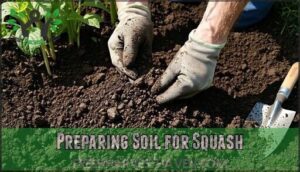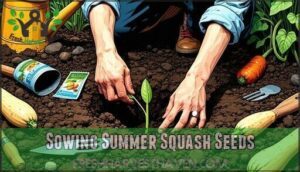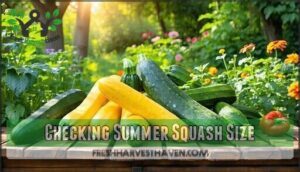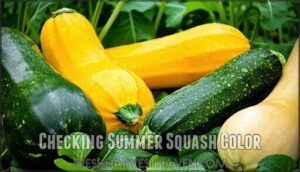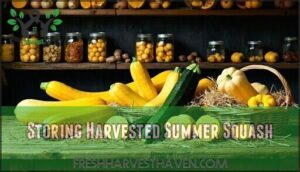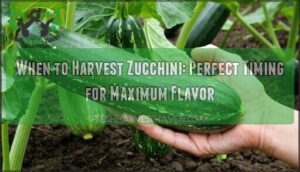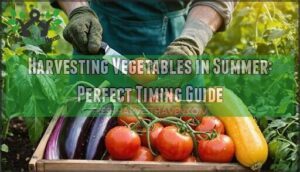This site is supported by our readers. We may earn a commission, at no cost to you, if you purchase through links.
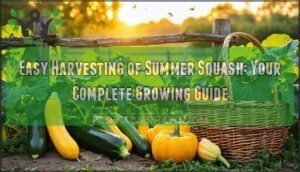 Most gardeners lose half their squash harvest to timing mistakes—picking too late turns tender vegetables into woody baseball bats, while harvesting too early means missing out on peak flavor. Summer squash doesn’t wait around, growing from perfect to over-sized in what feels like a single afternoon.
Most gardeners lose half their squash harvest to timing mistakes—picking too late turns tender vegetables into woody baseball bats, while harvesting too early means missing out on peak flavor. Summer squash doesn’t wait around, growing from perfect to over-sized in what feels like a single afternoon.
Mastering the rhythm of easy harvesting transforms your garden from a source of stress into a reliable food factory. The secret lies in recognizing the visual cues that signal readiness, establishing a picking schedule that keeps plants producing like clockwork, and knowing exactly how to manage each variety from the moment your knife cuts through that glossy skin.
Table Of Contents
- Key Takeaways
- Choosing Summer Squash Varieties
- When to Plant Summer Squash
- Preparing Soil for Squash
- Sowing Summer Squash Seeds
- Caring for Summer Squash Plants
- Identifying Ready to Harvest Squash
- Harvesting Summer Squash Flowers
- Storing Harvested Summer Squash
- Frequently Asked Questions (FAQs)
- How to tell when summer squash is ready to pick?
- What do squash plants look like when ready to harvest?
- How many squash will one plant yield?
- How big should I let my squash get before I pick it?
- How to avoid overripe summer squash during harvest?
- What tools are best for harvesting squash?
- When is the best time of day to harvest?
- How to handle squash plants without damaging them?
- Can overgrown squash still be used effectively?
- What tools are best for harvesting summer squash?
- Conclusion
Key Takeaways
- Harvest summer squash when it’s young and glossy—6-8 inches for zucchini, 3-4 inches for patty pan—because waiting even a day too long turns tender vegetables into tough, seedy disappointments.
- Check your plants daily during peak season since squash can balloon overnight in summer heat, and consistent picking at the right size keeps plants producing all season long.
- Plant seeds directly into garden soil once temperatures hit 60°F, space them 3-4 feet apart, and water deeply once or twice weekly rather than shallow sprinkling to build strong roots and prevent disease.
- Use sharp pruning shears or knives for clean cuts when harvesting, sanitize tools between plants to block disease spread, and harvest in cool morning hours when fruits are firmest and most flavorful.
Choosing Summer Squash Varieties
Your summer squash garden starts with picking the right varieties for your growing style and kitchen needs. Different types offer unique shapes, flavors, and growing habits that can make or break your harvest success.
Let’s look at the most popular options and what makes each one worth planting.
Popular Summer Squash Types
Summer squash varieties give you the power to design your ideal harvest. These five Garden Planning champions deliver serious Summer Harvest potential:
- Zucchini – Long cylindrical fruits excel in bread and stir-fries, packed with Squash Nutrition
- Yellow Squash and straightneck types – Bright, buttery flavor for countless Vegetable Recipes
- Patty Pan – Round, scalloped shapes perfect for stuffing and grilling adventures
- Crookneck – Bumpy, curved necks signal peak flavor readiness
- Unique hybrids – Combine the best Squash Varieties traits for maximum garden freedom
These types of squash are all Cucurbita Pepo varieties.
Zucchini and Crookneck Squash
While zucchini and yellow varieties dominate most gardens, zucchini and crookneck squash each bring their own growing personality to your summer beds. Zucchini churns out glossy, dark green cylinders perfect for everything from bread to stir-fries—harvesting at 6-8 inches locks in that tender texture and mild flavor packed with Squash Nutrition.
Crookneck squash takes a different path with its signature curved neck and bumpy yellow skin, signaling sweeter notes and peak Crookneck Benefits. Both Summer Squash Varieties grow fast, so daily checks during gardening season keep you ahead of oversized fruits. Master these Squash Varieties for total harvest freedom.
Round and Scalloped Squash
If you’re ready to break free from the zucchini-and-crookneck routine, patty pan and scalloped varieties bring a whole new shape to your harvest—and they’re just as easy to grow. These Heirloom Squash Types produce flat, scalloped discs that taste delightful when harvested at 3-4 inches. Patty Pan Recipes shine with grilling and stuffing—their unique Round Squash Uses make every meal feel adventurous while delivering serious Summer Squash Nutrition.
Why scalloped varieties deserve a spot in your garden:
- Commanding presence – Their striking shape instantly elevates market stands and dinner plates
- Bold flavor freedom – Mild, buttery taste suits any recipe you throw at it
- Rebellious harvest timing – Pick them young for tender bites or let them grow for dramatic stuffing vessels
- Total gardening control – Same care as standard Summer Squash with way more visual impact
- Adventurous cooking potential – From simple grilling to complex Patty Pan Recipes, these Squash Varieties never bore
When to Plant Summer Squash
Once you’ve picked your varieties, the next challenge is getting those seeds in the ground at the right moment. Don’t jump the gun—wait until soil temperature hits at least 60°F. Cold ground is a death sentence for tender seedlings. Use a soil thermometer instead of guessing based on air warmth.
Check your regional variations and last frost date, then add two weeks for good measure. This climate consideration protects your investment. Southern gardeners can start planting timing earlier, but northern zones need patience.
Proper soil preparation and seed selection mean nothing if your sowing seeds happens too early. Break free from the calendar—let the thermometer be your guide for summer squash success.
Preparing Soil for Squash
Getting your soil right isn’t complicated, but it makes all the difference when you’re growing summer squash. You need to check two things before those seeds go in the ground: temperature and conditions.
Let’s break down what your squash actually needs to thrive.
Soil Temperature Requirements
Soil warmth isn’t just a gardening detail—it’s your secret weapon for summer squash success. Before you drop those seeds into the ground, check that your soil temperature hits at least 60°F, though the ideal range for seed germination sits between 65°F and 75°F. Plant too early in cold dirt, and you’re gambling with your harvest.
Smart thermal management techniques can accelerate your planting timeline:
- Lay black plastic mulch to trap heat and boost ideal heating by several degrees
- Install cold frames for temperature control when spring weather turns unpredictable
- Water soil before chilly nights to store natural warmth
- Monitor daily readings with a soil thermometer for consistent results
Proper soil preparation through temperature monitoring transforms sowing seeds from guesswork into guaranteed results. Understanding summer squash growth is essential for a successful harvest.
Full Sun and Soil Conditions
Summer squash doesn’t ask for much, but sunlight and soil quality are two things you can’t negotiate. Your plants demand at least six hours of direct sun daily—no exceptions.
Soil pH levels between 6.0 and 6.8 create the foundation for explosive growth. Boost drainage systems with compost enrichment, mixing in organic matter that transforms heavy clay into friable gold.
Test soil temperature before planting; warmth accelerates everything. Proper soil preparation isn’t optional—it’s your ticket to freedom from garden failure.
Sowing Summer Squash Seeds
Once your soil’s warmed up and ready, it’s time to get those seeds in the ground. The way you sow makes all the difference between a bountiful harvest and a disappointing season.
Let’s break down the two key steps that’ll set you up for success.
Direct Sowing Into Garden Soil
The moment you press that seed into warm soil, you’re launching a race against time—and summer squash is built to win it. Once soil temperature hits 60°F, you’re free to sow directly into your garden bed. Skip the indoor seed-starting drama—these seeds thrive when planted straight into sun-warmed earth.
Here’s your planting blueprint:
- Seed spacing: Place seeds 3-4 feet apart for unrestricted growth
- Soil preparation: Blend compost into planting zones before sowing
- Watering needs: Keep soil moist but never soggy for ideal germination rates
- Pest control: Deploy row covers to shield young seedlings from invaders
Strong vegetable gardening starts with smart planting decisions.
Sowing Seeds at Correct Depth
Getting your seed depth right is like finding the ideal depth on a guitar – one inch deep hits the perfect note for summer squash success. Planting deeper buries seeds too far from sunlight, while shallow sowing leaves them vulnerable to drying out.
Here’s your Seed Depth Guidelines for perfect Seed Starting:
- Press seeds exactly 1 inch into prepared soil when Soil Temperature reaches 60°F
- Follow Seed Spacing Rules by positioning seeds 2-3 feet apart
- Apply Soil Preparation Tips by mixing compost into beds before Sowing Seeds
- Check Garden Bed Readiness through moisture testing at Best Sowing Times
These Summer Squash Gardening basics set you up for a harvest you’ll actually brag about.
Caring for Summer Squash Plants
Once your summer squash plants are in the ground, they’ll need the right care to thrive and produce abundantly. Consistent watering and proper support can make the difference between a struggling plant and one that cranks out squash all season long.
Here’s what you need to know to keep your plants healthy and productive.
Watering and Mulching Requirements
Want your squash to thrive without babysitting it? Nail your watering frequency and mulching strategy, and you’ll break free from daily garden stress. Summer squash needs 1 to 2 inches of water weekly—delivered as deep soakings, not shallow sprinkles. One thorough irrigation per week keeps soil moisture steady at the 4-8 inch depth where roots matter most. When heat waves hit, bump it up to twice weekly. Drip irrigation at 1 to 1.5 gallons per plant works like magic for consistent plant hydration without wetting leaves, which is your best disease prevention move.
Now layer on 3-4 inches of straw or grass clippings around your plants, leaving a 6-inch gap at stems. These mulch benefits are real: up to 70% less water evaporation, soil temps locked in that sweet 65-75°F zone, and 80% fewer weeds stealing your resources.
Climate adaptations matter too—arid regions may need three waterings weekly, while rainy spells call for thinning mulch to avoid root rot.
Supporting Summer Squash Plants
Let your summer squash plants climb instead of sprawl, and you’ll reclaim half your garden real estate while preventing the soggy-fruit disaster that ground-level growing invites. Trellis systems and staking methods redirect that vertical growth upward, boosting plant health through better air circulation and pest management. Cage aids work brilliantly for bushier varieties, while pruning benefits include removing leaf clutter that traps moisture. Install fixtures early—before roots spread—and maintain consistent plant hydration throughout the season. Your growing conditions improve instantly when fruits hang freely, staying dry and disease-free.
Break free from garden chaos with these aid strategies:
- Stake early to avoid root damage and watch your plants soar
- Prune aggressively to let sunlight penetrate every leaf
- Choose sturdy cages that won’t buckle under heavy fruit loads
- Space fixtures wide enough for airflow that kills fungal threats
- Inspect weekly for pests hiding in dense, unsupported foliage
Identifying Ready to Harvest Squash
Knowing when your squash is ready makes all the difference between tender, flavorful harvests and tough, oversized disappointments. You’ll want to check both size and color before cutting anything from the vine.
Here’s what to look for when your plants are loaded with fruit.
Checking Summer Squash Size
When your squash hits that just-right size—not too small, not too big—you’ve found the harvesting prime point most gardeners miss. Variety differences matter here—patty pan squash won’t follow the same rules as crookneck. Zucchini reaches ideal size at 6-8 inches, while yellow varieties shine at 4-6 inches for maximum tenderness.
Check your plants daily during peak season because growth rate accelerates fast in summer heat. Harvesting frequency keeps production going strong, and catching them at ideal size and shape means tender texture instead of tough, seedy disappointments.
Checking Summer Squash Color
Size gets your attention first, but color whispers the secrets of perfect ripeness that separate good harvests from great ones. Zucchini flaunts deep emerald green while yellow squash varieties blaze with golden brilliance—these summer squash shades signal peak flavor.
Visual inspection tips reveal glossy, vibrant skin color and texture that practically glows. Squash color variations matter: patchy or dull areas scream "wait longer." Watch for color change indicators showing uniformity across the entire fruit.
When squash maturity signs align—rich hues, no faded spots—you’ve cracked the harvesting code that transforms ordinary gardeners into unstoppable producers.
Harvesting Summer Squash Flowers
Don’t overlook the blossoms when your squash plants start flowering. Both male and female squash flowers are edible and offer a delicate flavor that gardeners have enjoyed for generations.
Here’s how to harvest and use these often-wasted blooms.
Edible Summer Squash Flowers
Those golden blooms peeking out from beneath broad leaves aren’t just garden decoration—they’re a gourmet ingredient hiding in plain sight. Both male and female flowers appear on your plants, but you’ll want to harvest the males since they won’t produce fruit. Pick these summer blooms early in the morning when they’re fully open and fresh. These edible flowers pack vitamins A and C plus folate, making squash blossoms a nutritious addition to your floral cuisine repertoire.
- Male flowers grow on long stems and outnumber females, making them perfect for harvesting without sacrificing your crop
- Morning harvest captures blossoms at their peak freshness before the summer heat causes them to wilt
- Delicate petals require gentle management—one bruise and these edible flowers lose their appeal
- Refrigerate your squash blossoms immediately in damp paper towels to extend their shelf life for a day or two
- Anyone with pollen allergies should test their tolerance before diving into flower recipes
Using Squash Flowers in Recipes
Once you’ve picked those morning-fresh blossoms, the real fun begins—turning them into dishes that’ll make your neighbors wonder why they’ve been tossing theirs on the compost pile.
Stuff these edible squash blossoms with ricotta or goat cheese, dip them in simple batter recipes, and fry until golden—the mild flavor profiles shine with Mediterranean cooking methods.
Toss raw blossoms into pasta as garnish options, or let stuffing ideas run wild with herbs and breadcrumbs for gourmet summer squash flowers.
Storing Harvested Summer Squash
You’ve picked your squash at peak ripeness—now don’t let it go to waste. Proper storage keeps your harvest crisp and flavorful, whether you’re using it within days or preserving it for months.
Let’s look at your best options for both short-term freshness and long-term preservation.
Short Term Storage Options
Your fridge becomes squash headquarters once you’ve got armfuls of zucchini to store. Keep them in the crisper drawer at 32-40°F, where they’ll stay firm for up to two weeks.
Use mesh bags or perforated plastic for proper humidity control and airflow—your squash needs to breathe. Rinse them with a chlorinated wash to remove field debris, but don’t scrub bruised ones you’ll cook right away.
Practice smart ethylene management by separating squash from ripening tomatoes or bananas that’ll speed up spoilage. These postharvest management techniques keep your harvest bounty fresh longer, giving you control over your food preservation timeline.
Long Term Storage Methods
Breaking free from short-term fridge limits means mastering food preservation techniques that put you in control. Freezing techniques deliver the best results—blanch your sliced squash for 3 minutes in boiling water, then plunge into ice water before packing into airtight containers. Frozen squash maintains peak quality for 10-12 months at 0°F.
Drying methods and pickling procedures offer shelf-stable alternatives:
- Dehydrate thin slices at 120-140°F for 8-12 hours until leathery
- Pack pickled squash in vinegar brine using proper canning strategies for year-long storage
- Label everything with dates for smart rotation
These methods transform your abundant harvest into winter provisions through smart postharvest management.
Frequently Asked Questions (FAQs)
How to tell when summer squash is ready to pick?
You’ll know your summer squash hits Harvest Timing when it’s young and glossy—4-6 inches for zucchini, 3-4 inches across for patty pan varieties.
Check Fruit Size daily since squash explodes in growth, and use sharp pruners for clean Stem Cutting to keep plants cranking out more.
What do squash plants look like when ready to harvest?
When harvest time arrives, you’ll notice glossy fruits hanging beneath vibrant green foliage.
The squash should feel firm to touch, with skin that’s smooth and tender—not hard or dull, which signals they’ve grown too large and past their prime.
How many squash will one plant yield?
A single summer squash plant pumps out 6-10 pounds per season—that’s 20-40 individual fruits if you’re harvesting regularly. Your yield depends on squash variety, plant density, harvest frequency, and consistent care.
Keep picking those baby zucchinis and crooknecks, and the plant rewards you all summer long with continuous production.
How big should I let my squash get before I pick it?
Summer squash shines when picked young—grab zucchini at 6-8 inches and patty pans at 4-6 inches diameter.
Wait too long and you’ll bite into tough, grainy flesh packed with oversized seeds instead of that tender, sweet flavor you’re after.
How to avoid overripe summer squash during harvest?
Check plants every day or two during peak season—squash can balloon overnight.
Snag them at 4-6 inches for zucchini or when they’re still firm and glossy, before skins toughen and seeds take over.
What tools are best for harvesting squash?
Sharp pruning shears or a clean knife deliver the cleanest cuts without tearing vines. Tools like Fiskars Multi Snip or quality garden clippers make quick work of harvest time.
Sanitize your cutting tools between plants—this simple step blocks disease spread and keeps production rolling strong all season.
When is the best time of day to harvest?
The early bird catches the worm—and the best squash. Harvest during cool morning hours when temperatures stay mild and your squash feels firm. Morning harvesting protects tender fruits from heat damage while daily checks guarantee peak picking at the perfect size.
You’ll maintain peak freshness by avoiding midday heat management challenges during squash ripening.
How to handle squash plants without damaging them?
Grab a sharp knife or pruning shears and cut stems cleanly—gentle treatment prevents damage to vines that’ll keep producing all season.
Skip the twist-and-pull move since it stresses plants, reduces yields, and opens wounds where disease creeps in.
Can overgrown squash still be used effectively?
While prized for tenderness, overgrown squash isn’t a lost cause—you’ve just got tougher fruit with big seeds.
Scoop out seeds for next season’s planting, toss thick flesh into compost bins, or simmer them into soups where texture disappears into flavor.
What tools are best for harvesting summer squash?
You’ll need a sharp knife or pruning shears to harvest summer squash cleanly. Clean cuts protect your plants from disease, so sanitize your tools between harvests and avoid twisting or pulling the fruit off the vine.
Conclusion
Garden folklore claims squash plants need coddling, but the truth reveals something wilder: these plants thrive on confident care and daily attention.
Easy harvesting of summer squash isn’t about flawlessness—it’s about building momentum through consistent checks, quick cuts, and trusting your instincts when that stem feels firm under your fingers.
Your garden won’t apologize for growing fast, so grab your knife at dawn and claim what’s yours before nature decides otherwise.
- https://ucanr.edu/program/uc-anr-small-farms-network/summer-squash-production-california
- https://extension.illinois.edu/gardening/summer-squash
- https://projects.sare.org/sare_project/fw06-042/
- https://journaljeai.com/index.php/JEAI/article/view/2270
- https://extension.okstate.edu/fact-sheets/squash-and-pumpkin-production.html


